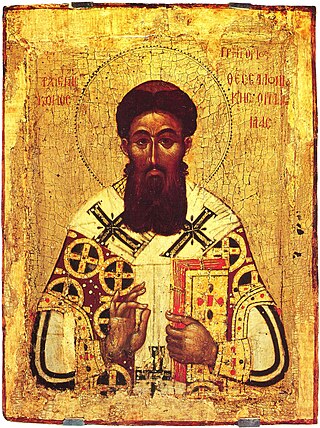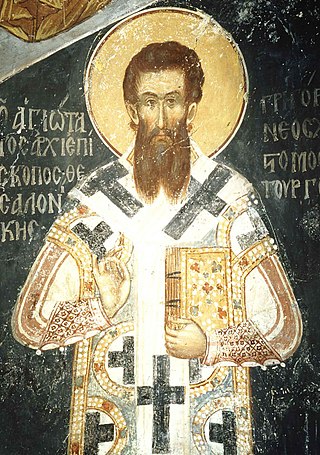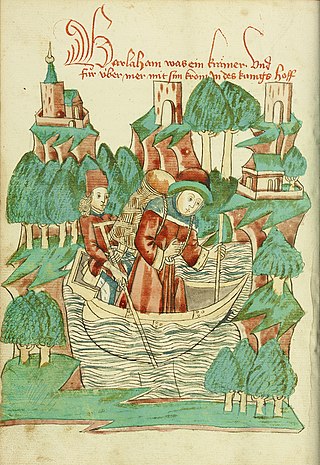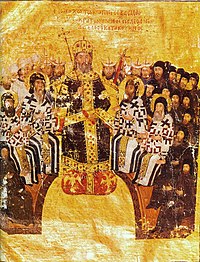
Hesychasm is a contemplative monastic tradition in the Eastern Christian traditions of the Eastern Catholic Churches and Eastern Orthodox Church in which stillness (hēsychia) is sought through uninterrupted Jesus prayer. While rooted in early Christian monasticism, it took its definitive form in the 14th century at Mount Athos.

Gregory Palamas was a Byzantine Greek theologian and Eastern Orthodox cleric of the late Byzantine period. A monk of Mount Athos and later archbishop of Thessalonica, he is famous for his defense of hesychast spirituality, the uncreated character of the light of the Transfiguration, and the distinction between God's essence and energies. His teaching unfolded over the course of three major controversies, (1) with the Italo-Greek Barlaam between 1336 and 1341, (2) with the monk Gregory Akindynos between 1341 and 1347, and (3) with the philosopher Gregoras, from 1348 to 1355. His theological contributions are sometimes referred to as Palamism, and his followers as Palamites.

Barlaam of Seminara, c. 1290–1348, or Barlaam of Calabria was a Basilian monk, theologian and humanistic scholar born in southern Italy. He was a scholar and clergyman of the 14th century, as well as a humanist, philologist and theologian.

Council of Constantinople can refer to the following church councils convened in Constantinople :
Philotheos Kokkinos was the Ecumenical Patriarch of Constantinople for two periods from November 1353 to 1354 and 1364 to 1376, and a leader of the Byzantine monastic and religious revival in the 14th century. His numerous theological, liturgical, and canonical works received wide circulation not only in Byzantium but throughout the Slavic Orthodox world.
Kallistos I was the Ecumenical Patriarch of Constantinople for two periods from June 1350 to 1353 and from 1354 to 1363. Kallistos I was an Athonite monk and supporter of Gregory Palamas. He died in Constantinople in 1363.
The Metropolis of Derkoi is a residential see of the Eastern Orthodox Church subject to the Ecumenical Patriarch of Constantinople and situated in the Istanbul suburb of Yesilköy. The cathedral is that of St. Parakevi in Therapia (Tarabya). The metropolitan is a member of the Patriarchal Synod. The present Metropolitan is Apostolos Daniilidis.
The history of the Eastern Orthodox Church is the formation, events, and transformation of the Eastern Orthodox Church through time. According to the Eastern Orthodox tradition, the history of the Eastern Orthodox Church is traced back to Jesus Christ and the Apostles. The Apostles appointed successors, known as bishops, and they in turn appointed other bishops in a process known as Apostolic succession. Over time, five Patriarchates were established to organize the Christian world, and four of these ancient patriarchates remain Orthodox today. Orthodox Christianity reached its present form in late antiquity, when the ecumenical councils were held, doctrinal disputes were resolved, the Fathers of the Church lived and wrote, and Orthodox worship practices settled into their permanent form.

In Eastern Orthodox Christian theology, the Tabor Light is the light revealed on Mount Tabor at the Transfiguration of Jesus, identified with the light seen by Paul at his conversion.
Gregory Akindynos was a Byzantine theologian of Bulgarian origin. A native of Prilep, he moved from Pelagonia to Thessaloniki and studied under Thomas Magistros and Gregory Bryennios. He became an admirer of Nikephoros Gregoras after he was shown an astronomical treatise of that scholar by his friend Balsamon in 1332, writing him a letter in which he calls him a "sea of wisdom". From Thessaloniki, he intended to move on to Mount Athos, but for reasons unknown, he was refused.

Palamism or the Palamite theology comprises the teachings of Gregory Palamas, whose writings defended the Eastern Orthodox practice of Hesychasm against the attack of Barlaam. Followers of Palamas are sometimes referred to as Palamites.

John XIV, surnamed Kalekas, was the Ecumenical Patriarch of Constantinople from 1334 to 1347. He was an anti-hesychast and opponent of Gregory Palamas. He was an active participant in the Byzantine civil war of 1341–1347 as a member of the regency for John V Palaiologos, against John VI Kantakouzenos.
Isidore I was the Ecumenical Patriarch of Constantinople from 1347 to 1350. Isidore Buchiras was a disciple of Gregory Palamas.

The 14th century saw major developments in Christianity, including the Western Schism, the decline of the Crusades, and the appearance of precursors to Protestantism.

Christianity in the Middle Ages covers the history of Christianity from the fall of the Western Roman Empire. The end of the period is variously defined - depending on the context, events such as the conquest of Constantinople by the Ottoman Empire in 1453, Christopher Columbus's first voyage to the Americas in 1492, or the Protestant Reformation in 1517 are sometimes used.

The Triads of Gregory Palamas are a set of nine treatises entitled "Triads For The Defense of Those Who Practice Sacred Quietude" written by Gregory Palamas in response to attacks made by Barlaam. The treatises are called "Triads" because they were organized as three sets of three treatises.
The history of Eastern Orthodox Christian theology begins with the life of Jesus and the forming of the Christian Church. Major events include the Chalcedonian schism of 451 with the Oriental Orthodox miaphysites, the Iconoclast controversy of the 8th and 9th centuries, the Photian schism (863-867), the Great Schism between East and West, and the Hesychast controversy. The period after the end of the Second World War in 1945 saw a re-engagement with the Greek, and more recently Syriac Fathers that included a rediscovery of the theological works of St. Gregory Palamas, which has resulted in a renewal of Orthodox theology in the 20th and 21st centuries.

The Hesychast controversy was a theological dispute in the Byzantine Empire during the 14th century between supporters and opponents of Gregory Palamas. While not a primary driver of the Byzantine Civil War, it influenced and was influenced by the political forces in play during that war. The dispute concluded with the victory of the Palamists and the inclusion of Palamite doctrine as part of the dogma of the Eastern Orthodox Church as well as the canonization of Palamas.
This is a timeline of the presence of Eastern Orthodoxy in Greece from 1204 to 1453. The history of Greece traditionally encompasses the study of the Greek people, the areas they ruled historically, as well as the territory now composing the modern state of Greece.
Chariopolis or Charioupolis, modern Hayrabolu in European Turkey, was a residential bishopric of the Patriarchate of Constantinople during the Byzantine Empire. Only a few of its bishops are known. After the Ottoman conquest in the 1350s, it became a titular see and disappeared entirely in the 15th century.









